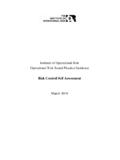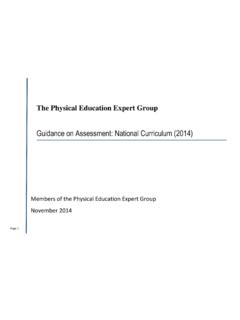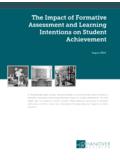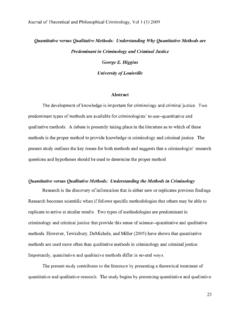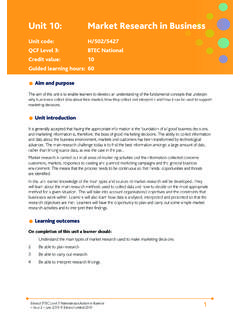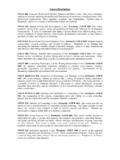Transcription of Teacher Guide PSYCHOLOGY - ocr.org.uk
1 AS and A LEVELT eacher GuidePSYCHOLOGYH167/H567 For first teaching in 1 Research Methods Question BankVersion 1 IntroductionThis booklet is intended to be a Guide only to the types of questions students may face in either the AS or A level examination for PSYCHOLOGY Component 1 Research methods. It is not example specimen papers. The questions are adaptations from the legacy papers that fit the content of the new contains a variety of questions for each content area which you may wish to use as a form of assessment for your students. You may wish to give this booklet to your students as a revision or independent study aid. Alternatively you may wish to use a section of questions from each content area to create your own assessments that fit with the current question requirements and sections of the new specification.
2 AS and A LEVELPSYCHOLOGYC omponent 1 examination Page 3 Specification summary Page Research methods and techniques Page Planning and conducting research Page Data recording analysis and presentation Page Report writing Page Practical activities Page How Science works Page 18 Introduction2 Copyright 2016 OCRC omponent 1 examinationComponent 1 examination The content for AS and A level is the same. The A level paper is greater overall in assessment difficulty. AS level 75 marks ( hours), 50% of total AS level. A level 90 marks (2 hours), 30% of total A reminder about the format of the Paper:AS Level 75 marksSection A15 Multiple choice questions. These contain four options each (one correct answer) and are worth one mark per question.
3 These can assess any part of the component. 15 Marks (20%)Section BResearch design and response: Students are required to answer all questions relating to a novel source. Students will be required to design their own piece of research and relate it to a practical they have marks (47%)Section CData Analysis and Interpretation: Students are required to answer all questions relating to a novel marks (33%)A Level 90 marksSection A20 Multiple choice questions. These contain four options each (one correct answer) and are worth one mark per question. These can assess any part of the component. 20 Marks (22%)Section BResearch design and response: Students are required to answer all questions relating to a novel source.
4 Students will be required to design their own piece of research and relate it to a practical they have marks (39%)Section CData Analysis and Interpretation: Students are required to answer all questions relating to a novel marks (39%)This paper challenges students to plan, conduct, analyse, and report psychological research across a range of experimental and non-experimental methodologies and techniques. It promotes an understanding of the methods of scientific enquiry used in empirical research and aims to develop relevant knowledge and skills for this process. It also encourages the acquisition of a range of evaluative concepts, reviewing and discussing the design outcomes of research and the application of such knowledge to the wider community, society and and confidence in a variety of mathematical procedures and problem solving skills should also be gained through involvement with practical 2016 OCRS pecification summary4 Copyright 2016 Research methods and techniquesLearners should have knowledge and understanding of the following research methods and techniques and their associated strengths and Lab, field, Structured and unstructured, naturalistic and controlled, participant and non-participant, covert and Questionnaires, Interviews (structured.)
5 Semi structured and unstructured)Correlations Obtaining data for a correlational analysis, positive, negative and no correlation. Planning and conducting researchLearners should be familiar with the following features of planning and conducting research and their associated strengths and and hypothesis and how to formulate Research aim, research question, null hypothesis, alternate hypothesis, one tailed (directional) hypothesis, two tailed (non-directional) , samples, and sampling techniques Target population and sample, random sampling, snowball sampling, opportunity sampling, self-selected designs Repeated measures, independent measures, matched participants and how they are operationalised Independent variables, dependent variables, control of extraneous variables.
6 Designing observations Behavioural categories, coding frames, time and event self -reports Open questions, closed questions, rating scales: Likert rating scale, semantic differential rating scale. Data recording, analysis and presentationLearners should be able to demonstrate knowledge and understanding of the procedures involved in the collection, analysis and presentation of data. This will necessitate the ability to perform some data Design of raw data recording tables, use of raw data recording tables, standard and decimal form, significant figures, make estimations from data and types of data Nominal, ordinal and interval level data, qualitative and quantitative data, primary and secondary statistics Measures of central tendency (mean, median, mode), measures of dispersion (variance, range and standard deviation).
7 Ratios, percentages, fractions, frequency tables, line graph, pie chart, bar chart, histogram, scatter statistics Normal and skewed distribution curves, probability, significance levels, using statistical tables of critical values , criteria for using a parametric test, criteria for using a specific non parametric test (Mann Whitney U test, Wilcoxon signed ranks test, Chi square, binomial sin test and spearman s Rho), type 1 and type 2 errors, symbols: =, <, <<, >>, >, , ~. Methodological issues Representativeness, generalisability, reliability (internal, external, inter rater, test retet, split half ). Validity (internal, external, face, construct, concurrent, criterion, population, ecological). Demand characteristics, social desirability, researcher/observer bias and effects.
8 Ethical considerations including the British Psychological Society (BPS) code of ethics and conduct: Respect informed consent, right to withdraw, confidentiality, Competence, Responsibility protection of participant, debrief, Integrity summarySpecification summary5 Copyright 2016 Report writing Learners should have knowledge of the conventions of reporting research in a practical report and demonstrate understanding of the role and purpose of each of the main sections and sub and sub sections of a practical report Abstract, introduction, method (design, sample, materials/apparatus, procedure), results, discussion, references, academic references A familiarity with citing academic research using the Harvard system of referencing.
9 Peer review Appreciate the role of the psychological community in validating new knowledge and ensuring integrity through the process of peer Practical activitiesLearners are expected to conduct and analyse their own small scale research practical s including appropriate risk assessment and should have experience of the following practical activities: Self reports Experiments Observations Correlations. How science worksLearners should understand how society makes decisions about scientific issues and how PSYCHOLOGY contributes to the success of the economy and society. Learners should be aware of the nature and principles of scientific enquiry through knowledge and understanding of the following concepts: The study of cause and effect, falsification, replicability, objectivity, induction, deduction, hypothesis testing, manipulation of variables, control and standardisation, quantifiable Research methods and techniques6 Copyright 2016 Research methods and techniquesExperiments A researcher has conducted an independent measures design experiment to investigate whether chewing gum influences concentration.
10 She recorded how many changes were detected in a spot-the-difference puzzle by people chewing gum when completing the task, compared to those who were not. The results are in the table two variables present in a lab experiment. (2)Outline one strength and one weakness of using a lab experiment. (6)Explain the difference between a lab experiment and a field experiment. (4)What is a quasi experiment? (2)Why would a quasi experiment not be appropriate for this study? (2)State a strength and a weakness of using quasi experiments. (4)ObservationsA researcher wanted to covertly observe how mums at a play and stay interacted with each other. He planned to use a naturalistic structured one strength and one weakness of conducting observational research.










